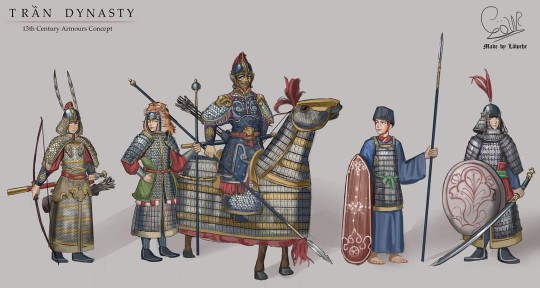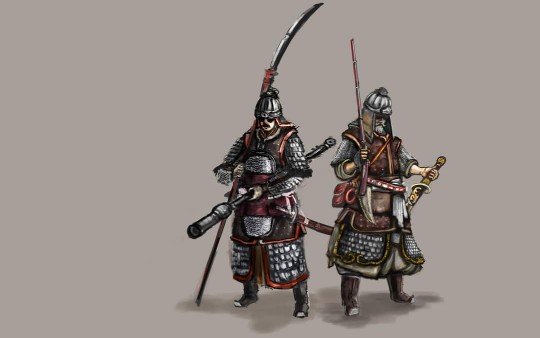The time has come to show off my idea of the Dai Viet Dynasty. I am a little worried about having gone overboard with them, but I really wanted to make a Civilization that could effectively Guerilla fight in AoE4. So please do come with feedback and criticism! I would love to hear your input! Also a personal Note to any Vietnamese reading this: The way you guys name medieval weaponry is absolutely maddening! They sure sound epic, but it does make searching up for the hell of a lot harder.
Dai Viet
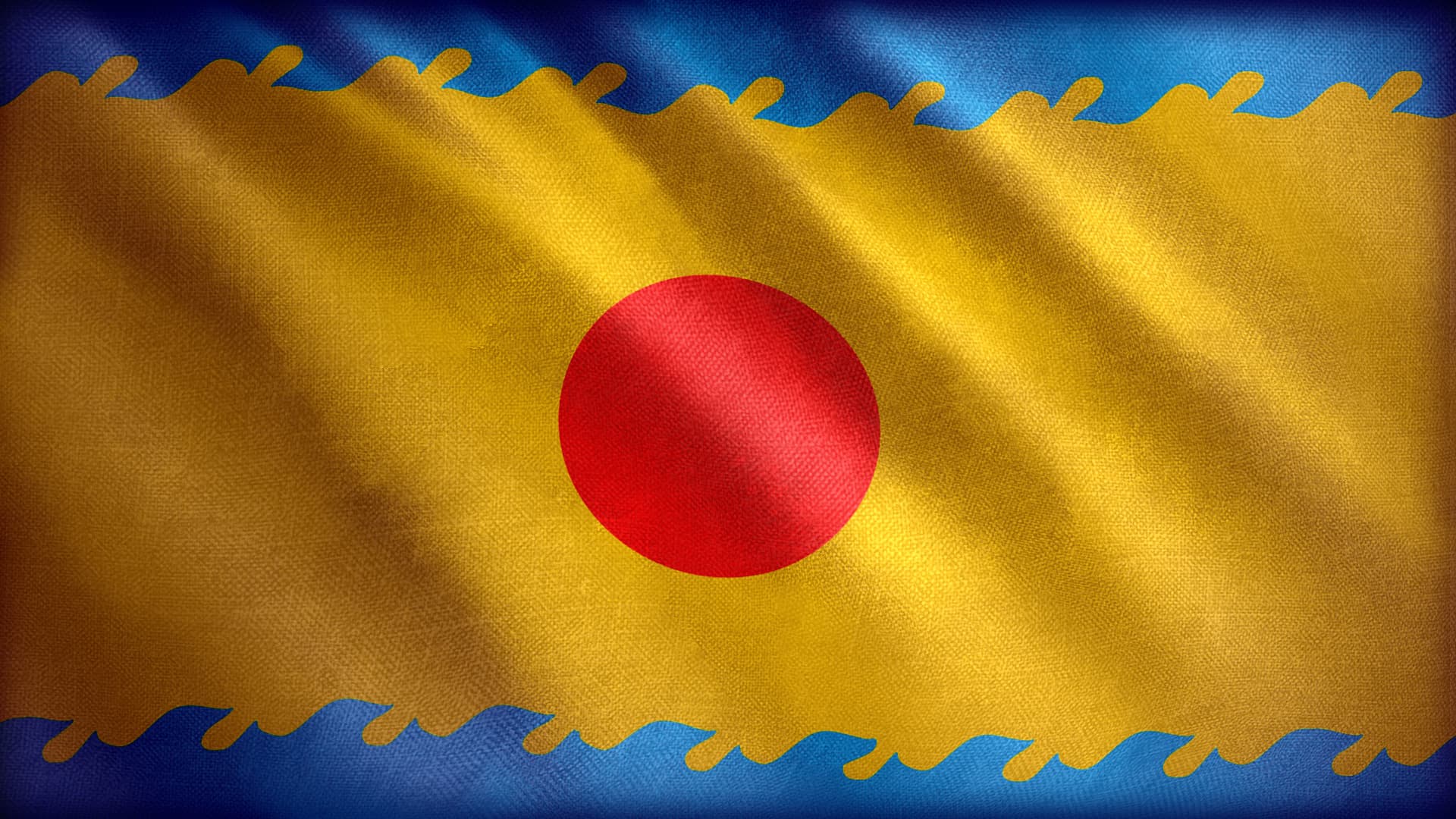
Special thanks for Seicing from AoE4 official forums!
Vietnamese Dynasties
Gunpowder, Guerrilla, Defensive
Difficulty: 1/3
Bonuses
- Villagers are affected by all infantry Blacksmith and University upgrades.
- Garrison Villagers applies double the Garrison effect (Shoots 2 arrows per villager garrisoned)
- Enemies Units within TownCenters, Docks, Outposts, Towers, Keeps, and Military Production building influence range, increases Military Unit production speed by 50% (Resistance)
- Units in stealth forests do 25% more damage.
- Unique Building: Hideout
- Unique Unit: Nỏ thần (Replaces Crossbows)
- Unique Unit: Giao Chỉ Arquebusier (replaces Cannoneers)
- Unique Unit: Voi Chiến
Ngụ Binh ư nông: Houses provide 1 Conscription point every 1m (Up to 20 Houses). Each House provides 2 Maximum Conscription points, up to a maximum of 10/20/30/40 Points. Garrisoned villagers can be converted into a Military Infantry unit for 1 point per villager, chosen by the Building they are garrisoned within. Garrisoned Military Infantry units can be converted into Villagers for 1 Conscription point per military unit.
Unique Landmarks:
Feudal Age
- Temple of Literature: All upgrades are 50% cheaper and researched 100% faster, Functions as University in age IV. Unlocks Monetary Reform technology.
- One Pillar Pagoda: Can produce villagers and can store up to 1 relic, increasing production speed by 100%. (Does not function as a town center or resource drop-off point)
Castle Age
- Binh Khuong Shrine: Increases conscription points by 10 and maximum conscription point limit by +10.
- Ho Citadel: Functions as a keep. Increases Hideout Garrison size by +10 and vision range by +2.
Imperial Age.
- Thiên Mụ Temple: Can convert every 1 Conscription Point into 13 Gold. Villager movement speed increased by 15%
- Doan Mon Gate: Doubles as a fully upgraded Keep and Gatehouse, and can be connected with walls. Units Garrisoned in hideouts, can be un-garrisoned from this building. Units Garrisoned in the Doan Mon gate can be un-garrisoned at any hideout.
Wonder: Bút Tháp Temple
Notes
Unique Buildings:
- Hideout (I, 75W): Can garrison and hide away up to 5 units, can only be revealed by enemy scouts, or enemies moving directly on top of it.
Unique Units:
- Nỏ thần (III, 80F 15W 15G): Crossbow unit that functions as a normal Crossbow, however, it has the ability to Deploy the Crossbow allowing it to fire multiple shots in a cone in front of it.
- Giao Chỉ Arquebusier (IV, 90F 90G): Strong gunpowder unit that does +10 damage to Heavy Armor units. Piercing Shot ability can be unlocked, with 35s cooldown time.
- Voi Chiến (III, 400F 500G): Elephant cavalry with the ability to Transport/Garrison up to 2 units. Giving it added firepower in form of arrows.
Technologies
- Rattan Đằng-Bài Shields (II, 150W): Archers gain +2 Pierce armor. Upgraded at Blacksmith
Early 13th century vietnamese rattan shield
- Resilience (II, 200F 100G): Villagers gain +4 Armor within Resistance Influence Area, Upgraded at Blacksmith.
- War Tattoos (II, 100F 50G): Increases HP for all military units by 5%, Researched at Blacksmith
- Hồng ngọc sương (III, 200F 150G): All Non-siege units passively heals for +1HP every 4 seconds when out of combat. Upgraded at Monastery.
Illustration of a potential Feudal or Castle Era Dai Viet MaA
- Annam Firelances (III, 200F 200G): Spearmen fire off a ranged attack before charging or bracing. Researched at Blacksmith.

Annamese(Dai Viet) Fire lances
- Vườn không nhà trống (III, 150W 100G): Deleting structures return 70% of its value.
- Side Carriage (III, 100W 200G): Increases Voi Chiến Garrison capability by +3.
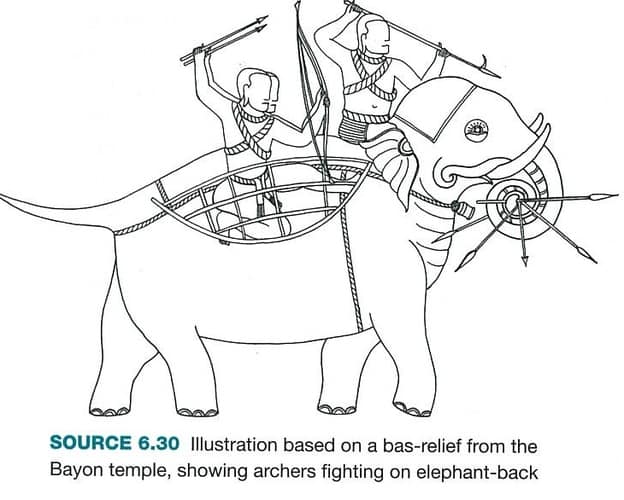
Illustration of the Dai Viet elephants from the Khmer Empire
- Monetary Reform (III, 150F 200G): Villagers gathering wood return 0.35 of the base Wood value as Gold additionally. Upgraded at Town Center.
- Nationalism (IV, 300F 700G): Reduces the time it takes to produce infantry, cavalry, siege and transport units by -25%. Upgraded at Keep.
- Firearm Instructors (IV, 300F 700G): Giao Chỉ Arquebusier provides an aura that increases attack speed for all Gunpowder units by 25%. Upgraded in University.
- Piercing Shot (IV, 1000G): Giao Chỉ Arquebusier gain the Piercing Shot ability, which causes their next shot to damage up to 2 units behind the target in a straight line. (Cooldown resets after the shot has been made) Upgraded at University.
Additional Notes:
Architecture varies to some degree, Traditional houses in Vietnam were characterized by wooden structures topped by steep roofs. The roofs would be covered with fish-scale tiles and curve outwards, while beams and rafters held up the main building. In some places, stilt houses were built and the houses usually had an odd number of rooms. However, the coming of various dynasties shaped cultural landmarks in the country in different ways. Over the Ages, the buildings will become more and more Sinicized with their own distinct flair.
The feudal age representing The Ly Dynasty of the 11th century, for example, was deeply influenced by Buddhism and incorporated intricate reliefs and motifs into their architecture.
Castle Age representing the Tran dynasty*,* which gained a foothold in the 13th century, brought its own set of beliefs and customs that made its mark in Vietnam’s architectural history. Buildings became more complex and demarcated, and gardens became a part of temples and places of worship.
Imperial Age representing the Le Dynasty thrived in the 16th and 17th centuries and witnessed the rise of folk art and sculpture being used in contemporary carvings and paintings.
Naval units would be a mix of junk-style, ships, however their early ships (arrow ships) would be elongated boats with multiple oars, and their Imperial cannon boats would be their own style that is more of a mix between a Chinese War Junk and a Portuguese Galley.
Language progression: The Vietnamese language belongs to the Austroasiatic language family, in its own subgroup called Viet-Muong. In the early days, Vietnamese shared more characteristics common to other languages in South East Asia and with the Austroasiatic family, such as an inflectional morphology and a richer set of consonant clusters, which have subsequently disappeared from the language under Chinese influence. Vietnamese is heavily influenced by its location in the Mainland Southeast Asia linguistic area, with the result that it has acquired or converged toward characteristics such as isolating morphology and phonemically distinctive tones. The ancestor of the Vietnamese language is usually believed to have been originally based in the area of the Red River Delta in what is now northern Vietnam. Distinctive tonal variations emerged during the subsequent expansion of the Vietnamese language and people into what is now central and southern Vietnam through the conquest of the ancient nation of Champa and the Khmer people of the Mekong Delta in the vicinity of present-day Ho Chi Minh City, also known as Saigon. The Vietnamese would progress their language throughout the ages, starting off;
- Dark Age: Proto-Vietnamese*,* the oldest reconstructable version of Vietnamese, dated to just before the entry of massive amounts of Sino-Vietnamese vocabulary into the language, c. 7th to 9th century AD. At this stage, the language had three tones.
- Feudal Age: Archaic Vietnamese*,* the state of the language upon adoption of the Sino-Vietnamese vocabulary and the beginning of the creation of the Vietnamese characters during the Ngô Dynasty, c. 10th century AD.
- Castle Age: Ancient Vietnamese**,** the language represented by Chữ Nôm (15th century), widely used during the Lê and the Chinese–Vietnamese, and the Ming glossary “Annanguo Yiyu” By this point, a tone split had happened in the language, leading to six tones but a loss of contrastive voicing among consonants.
- Imperial Age: Middle Vietnamese*,* the language of the Dictionarium Annamiticum Lusitanum et Latinum of the Jesuit missionary Alexandre de Rhodes (17th century) the dictionary was published in Rome in 1651. Another famous dictionary of this period was written by P. J. Pigneau de Behaine in 1773 and published by Jean-Louis Taberd in 1838.
Landmark references:
Temple of Literature:
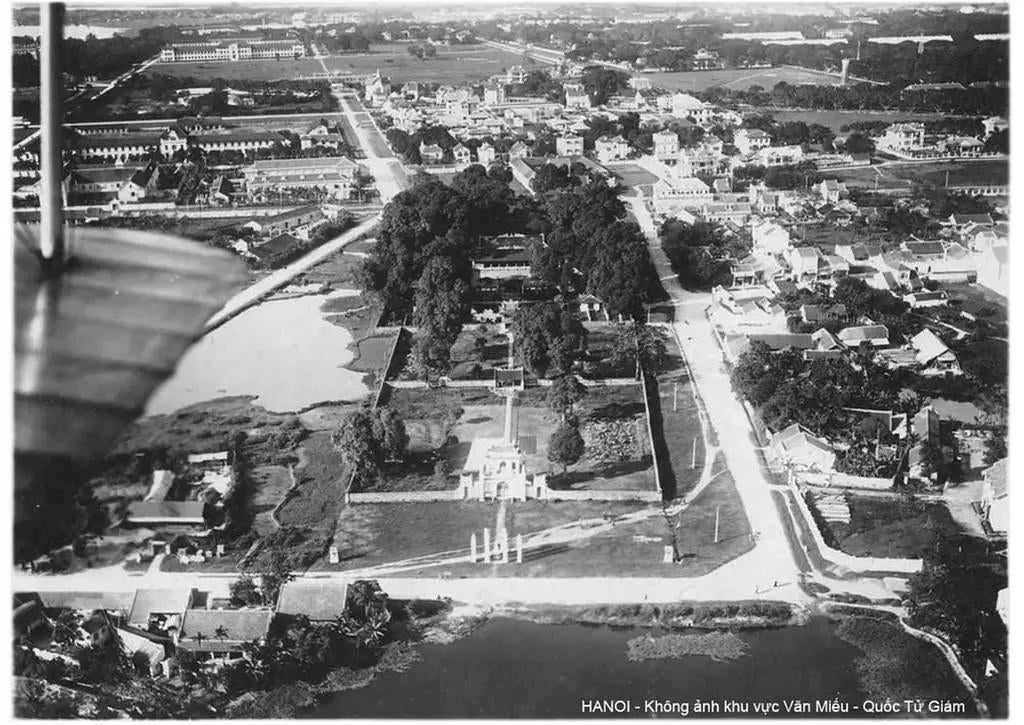
Old picture showing the 3 entry gates to the temple in the back
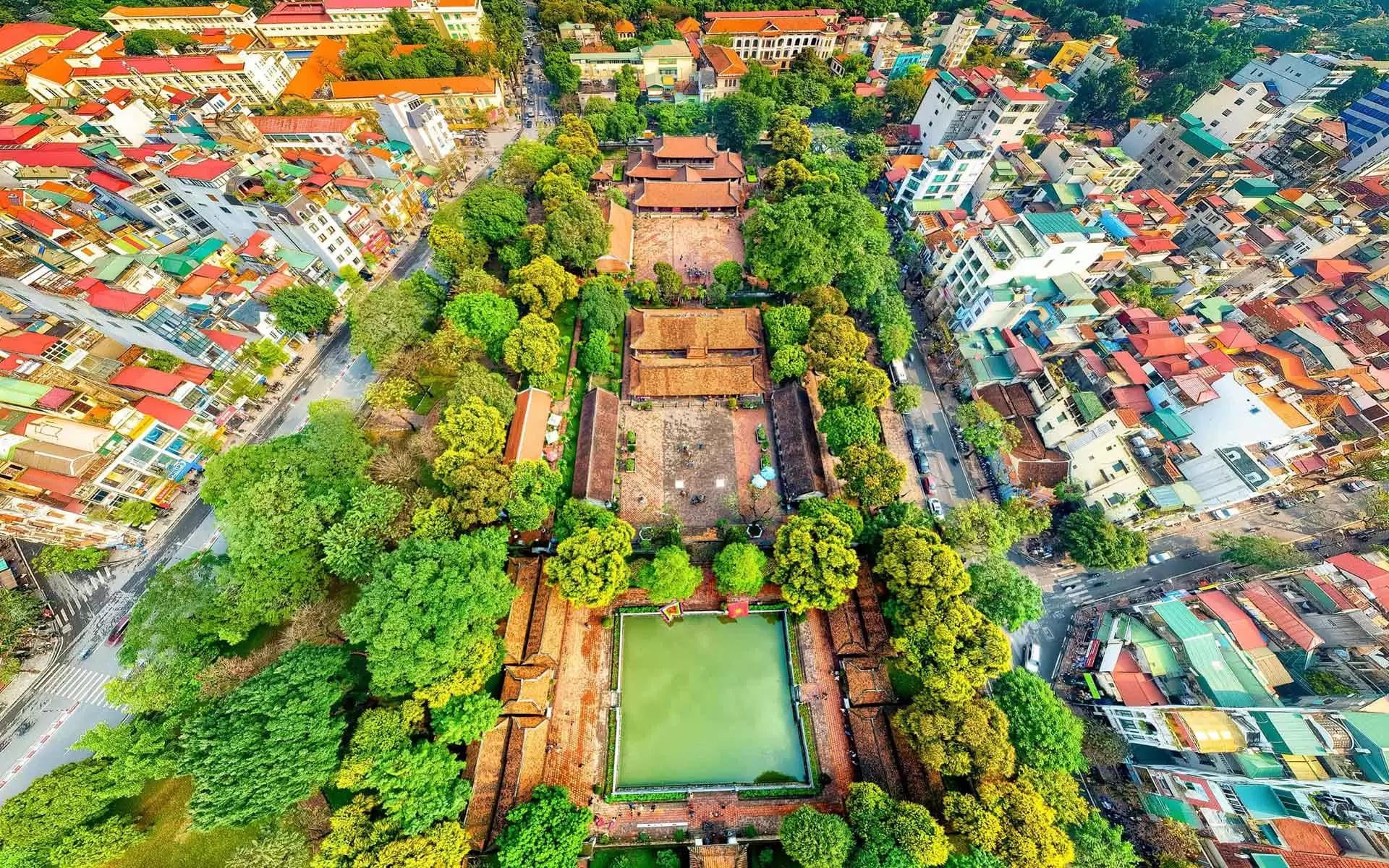
After the reconstruction from the Vietnam War
Built by Emperor Lý Thánh Tông, it was Vietnam’s first National University. Despite nearly two centuries, of wars and disasters, the temple preserved ancient architectural styles of many dynasties as well as precious relics.
One Pillar Pagoda:
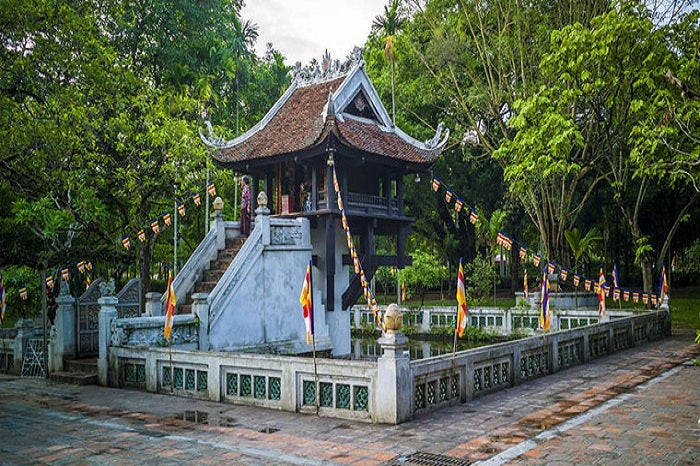
One Pillar Pagoda in Hanoi
Built by Emperor Lý Thái Tông (Father of Lý Thánh Tông), as a token of gratitude to the Bodhisattva Avalokiteshvara, who handed him a baby son while seated on a lotus flower in a dream, as the Emperor was Childless. Shortly after, he met a peasant girl who bore him a son. The Temple was said to be constructed in the lotus pond that he saw in his dreams. The temple was the site of Annual royal ceremonies on the occasion of Vesak, the birthday of the Guatama Buddha.
Binh Khuong Shrine:
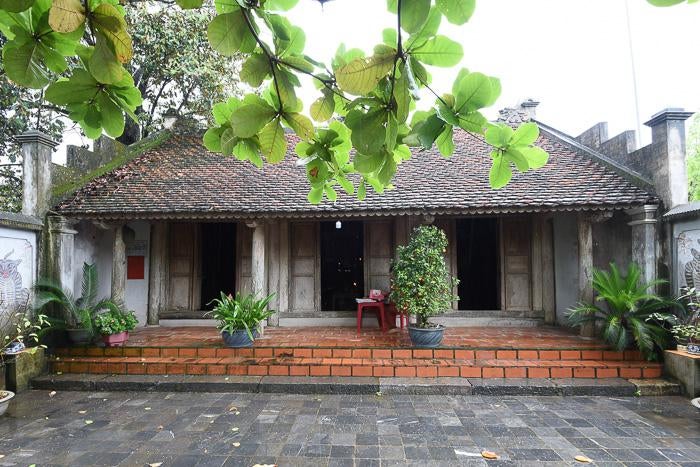
The Temple honors the spirit of Binh Khuong, a young widow who died protesting her husband’s unjust execution of being buried alive.He was proclaimed a traitor by the current Emperor Hồ Quý Ly, who had her Husband being a Supervisor overseeing the construction of the walls of a mighty fortress. As the four walls were on the verge of completion, the earth suddenly subsided under the east wall, bringing a large section crashing down. Although he survived the accident, the emperor was incensed and ordered his execution believing that the Supervisor had sabotaged the design and was ordered to be buried alive beneath the east wall as a warning to any other “traitors”.The Wife hearing the news, rushed to the spot where her husband was buried and demanded the Emperor to give him a proper burial. She decided to take matters into her own hands and started to move and chip away at the heavy stones herself, in frustration she banged her head against one of the stones and clawed at it until her body was raw and bloody. Eventually succumbing to the injuries. In 2009 during renovation, the bones of a young woman were found at the presumed location, and it was believed to be the remains of Bin Khuong herself, the remains were buried with full Buddhist ceremony, and the temple remains in active use today by local villagers who gather there every full moon to pay their respects.
Ho Citadel:
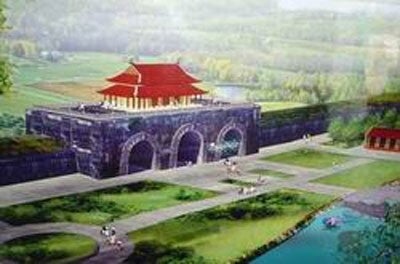
Artwork of HO Citadel
The Ho citadel was built by Hồ Quý Ly, the founder of the short-lived Ho dynasty (less than 10 years), he was emperor in all but name only, as Trần Thiếu Đế still held on as the nominal ruler. Partly in an attempt to distance himself further from Trần centers of power, and to bring the seat of government closer to the Cham threat in the south, Hồ Quý Ly decided to move the country’s capital to a new location in Thanh Hoa province. He dubbed the new capital Tay Do, the western capital, in opposition to the old capital of Thang Long (and the seat of Trần authority) which was renamed Dong Do.
Thiên Mụ Temple:

Thiên Mụ Temple complex
Built in 1601, it was related to the dream of Nguyen Lord. According to the royal annals, First Nguyen Lord while traveling the vicinity, was told of the local legend in which an old lady, known as Thiên Mụ (in Vietnamese “Celestial Lady”), dressed in red and blue sat at the side, rubbing her cheeks. She foretold that a lord would come and erect a pagoda on the hill to pray for the country’s prosperity. She then vanished after making her prophecy. Upon hearing this, First Nguyen Lord ordered the construction of a temple at the site, so it became the pagoda we visit today.
Doan Mon Gate:
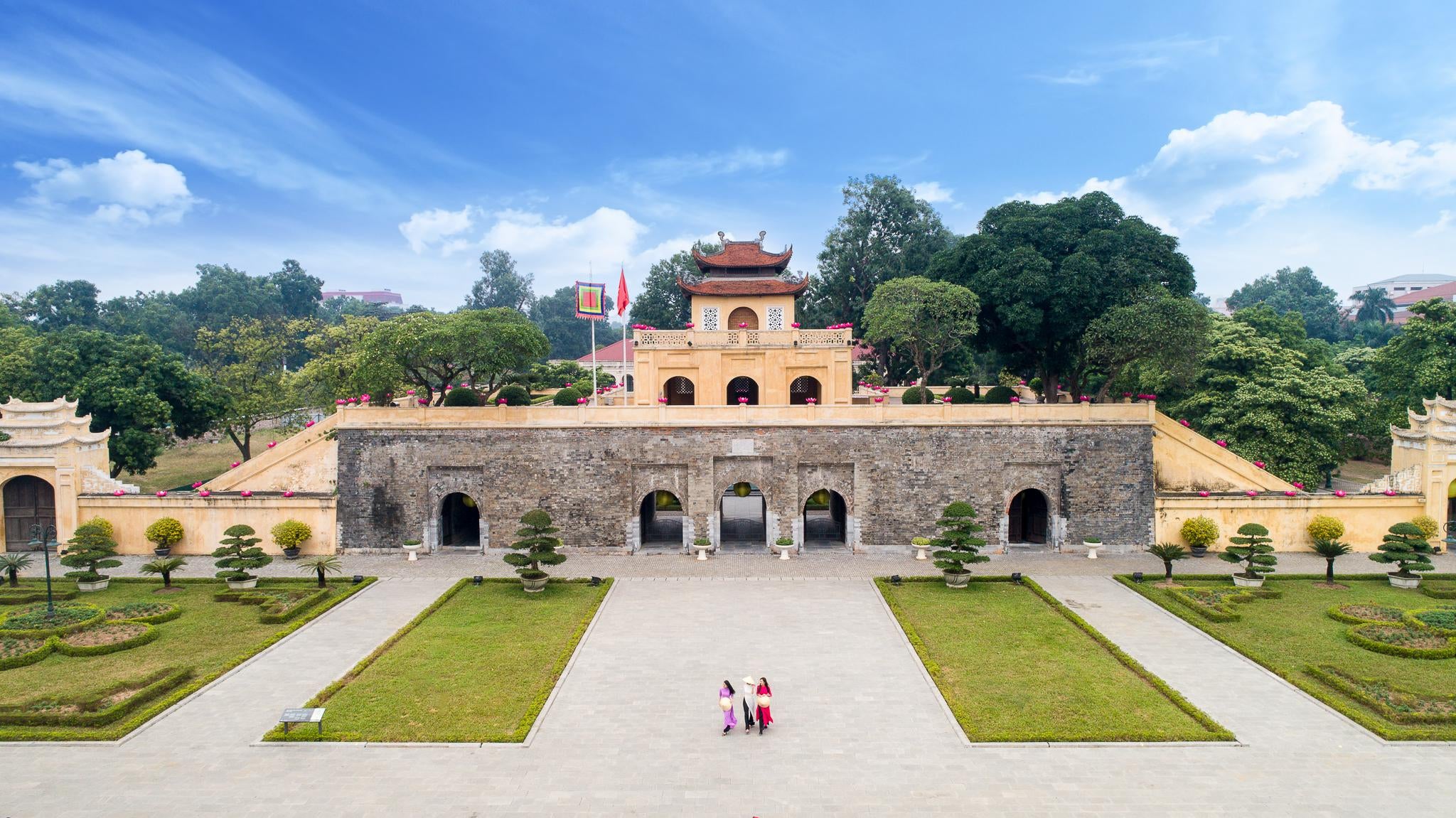
Main gate to the Imperial palace
Doan Mon is one of the main entrances to the Imperial Citadel of Thang Long, considered a Forbidden City of Vietnam. Based on construction materials and the remaining architectural style of the relics, it can be affirmed that the current Doan Mon was built under Le Dynasty and restored in Nguyen Dynasty. The royal enclosure was first built during the Lý dynasty (1010) and subsequently expanded by the Trần, Lê, and finally the Nguyễn dynasty. It remained the seat of the Vietnamese court until 1810 when the Nguyễn dynasty chose to move the capital to Huế. The ruins roughly coincide with the Hanoi Citadel today.
Wonder: Bút Tháp Temple: The temple is also popularly called Nhan Thap Temple. The temple was built in the 13th century. The temple houses the largest Avalokiteśvara statue with one thousand eyes and a thousand arms. But Thap Temple is one of the most famous temples in Viet Nam. Inside, there are various valuable ancient objects and statues, which are considered to be Vietnamese masterpieces of 17th-century wood carving. Inside the temple are more than 50 statues of different sizes including the Triad Buddha, Manjusri (Van Thu) on a blue lion, and Samantabhadra (Pho Hien) on a white elephant. The most remarkable is the thousand-handed and thousand-eyed Guanyin, which is described as a sculptural masterpiece of Vietnam.
Unique Building:
Hideout:
- Health: 300
The hideout is a building that has the trait of being in a stealth forest, meaning that enemies unit view range to spot a hideout is the same view range they have in stealth forests. This means they are easily exposed by scouts, but much harder to come across by regular units. The hideout can garrison up to 5 units, but with a landmark, up to 10 units.
Unique Unit:
- Health: 80/95
- Attack: 12/15 Ranged (Crossbow); 12/15 Ranged (5 Burst Attack) (Nỏ thần); +9/+11 vs Heavy
- Rate of fire: 2s (Crossbow); 3.3s (Nỏ thần);
- Range: 5 tiles
- Armor: 1/2
- Pierce Armor: 0
- Speed: 1.12 tiles/s
Nỏ thần Crossbowmen function, as regular crossbowmen, however, they have a unique skill that allows them to deploy the Nỏ thần Crossbow, becoming stationary, but able to fire a cone of Arrows in front of them, similar to a rebalderquin. Hitting multiple targets, at the cost of a slower fire rate.
- Health: 150
- Attack: 35 Ranged (Arquebus); +10 vs Heavy
- Rate of fire: 2s Ranged (Arquebus);
- Range: 4 (Arquebus)
- Armor: 0 Pierce Armor: 0
- Speed: 1.13 tiles/s
Giao Chỉ Arquebusier functions as a gunpowder unit with additional bonus damage vs Heavy units.It also has a unique ability when unlocked, which allows the next shot to fire a shot that goes through the target and hit up to 2 adjacent targets behind it with a damage drop-off per hit.
Voi Chiến:
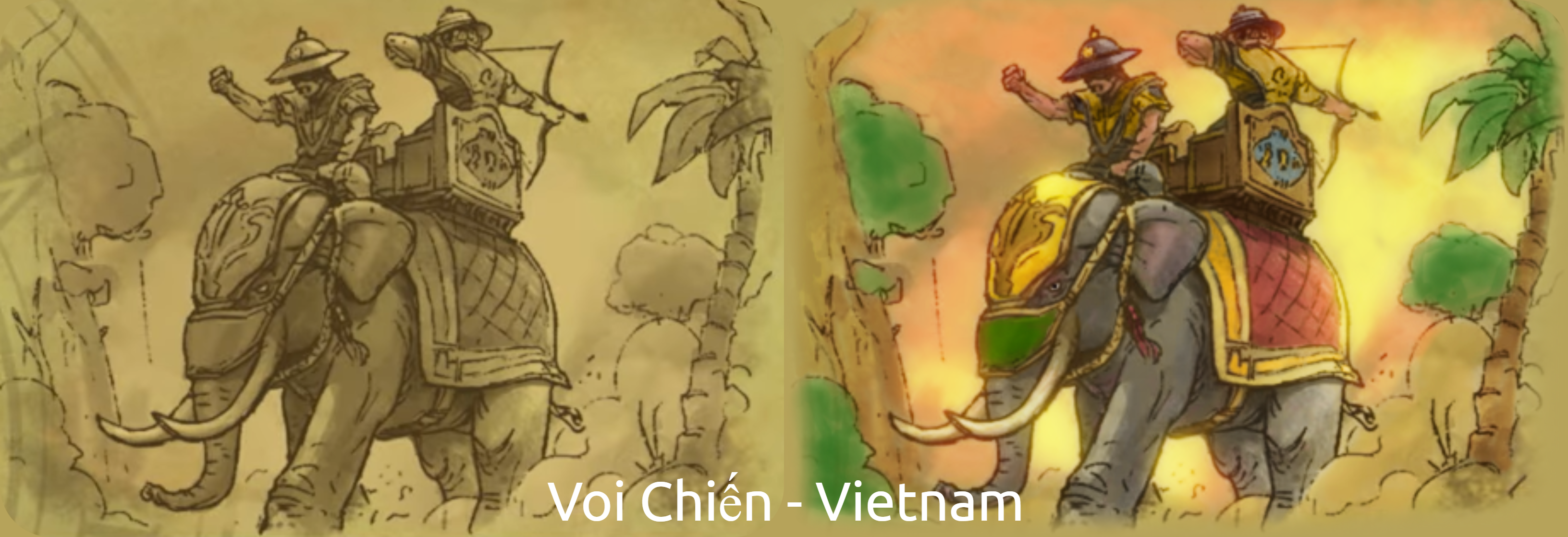
Civ6 Vietnam war elephant
- Health: 880
- Attack: 14 Ranged (Bow); +14 vs Light Melee; 30 Melee (Tusks); +70 vs Building (Tusks)
- Rate of fire: 1.25s Ranged (Bow); 2.75s (Tusks) Range: 5 (Bow)
- Armor: 0
- Pierce Armor: 3
- Speed: 0.88 tiles/s
War Elephants of the Vietnamese is able to garrison units for additional firepower. Similar to a Tower. Strong against Light melee infantry, and able to effectively destroy buildings with its melee attacks.
Write-up:War, War never changes. Well, one could say that about Vietnam. Vietnam never changes.Reading up on its History one quickly realizes, that the Vietnam war America waged on Vietnam, was nothing but a drop in the ocean of the countless wars Vietnam has had to deal with against empires and nations, far bigger and greater than themselves.Yet they never lost a war. And by that I mean, sure they lost battles and were pushed back. But they always came out the victor at the end of each war.So no wonder the Americans had such problems against the Vietnamese.While the Vietnamese might have a lot of internal conflict among themselves.If it’s one thing that unites them quickly, is an outside threat. Able to set aside their differences temporarily to effectively fight back against the enemies.And it is one of the things I really wanted to reflect on with the Vietnamese.
I gotta say though, It was surprisingly hard to do thorough research on the Vietnamese. Not due to lack of information. But due to a lot of information being locked behind the Vietnamese language, and Chinese claims over Vietnamese heritage. And on top of it all. Trying to filter through what might be “propaganda” Both by the Vietnamese, and modern-day China.
However, one thing came out clear. Vietnam and Gunpowder. While the Chinese might have invented gunpowder. Vietnam quickly became true masters of Gunpowder. Quickly adapting Arquebuses and Firelances, and many other forms of gunpowder weapons and inventions. The Ming Dynasty quickly realized the superiority of craftmanship of the Dai Vietnamese weapons (known to china as the Annamese), especially the Firelance, they started importing Vietnamese weapons at masse and hiring Vietnamese Instructors for the use and training of the weapons.
While the Europeans and especially the Ming Dynasty were fond of their Arquebuses more commonly known as the Jiaozhi Arquebus. Being exceptionally accurate with a devastating penetration force for its era, easily penetrating most armor in the region.It was very similar Java Arquebus that was Pioneered by the Majapahit empire to the south. (Malay people). And it was this early and rapid adaptation of Gunpowder weapons that gave the Vietnamese an edge over its neighbors and eventually had them conquer their neighbor of Champa. And they were profound guerrilla fighters, fighting in much the same manner against their ancient enemies, as they did in recent times against the Americans. Although I couldn’t find any documents about them making tunnels, they did have several hideouts they would stock up on food and supplies after applying scorched earth tactics in their own lands to starve the enemies. This was a doctrine that was well engraved in the Vietnamese mindset, often going by the expression Lấy sức nhàn thắng sức mỏi (Our troops in good health smite the tired enemy troops). Which they applied efficiently against several Mongol and Chinese invasions. And giving the mongols a taste of their own hit-and-run Tactics.
If you enjoyed this read, you can check up on my other Civilization concepts:
Southeast Asia:
The Dai Viet Dynasties
East Asia:
Europe:
Next up: Burmese
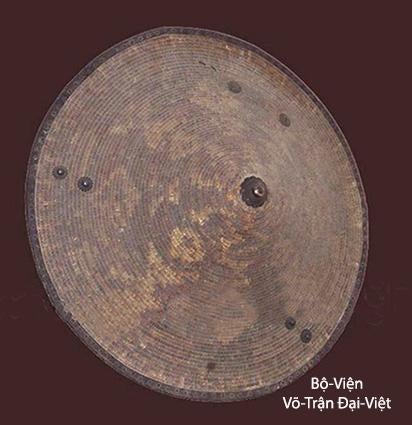
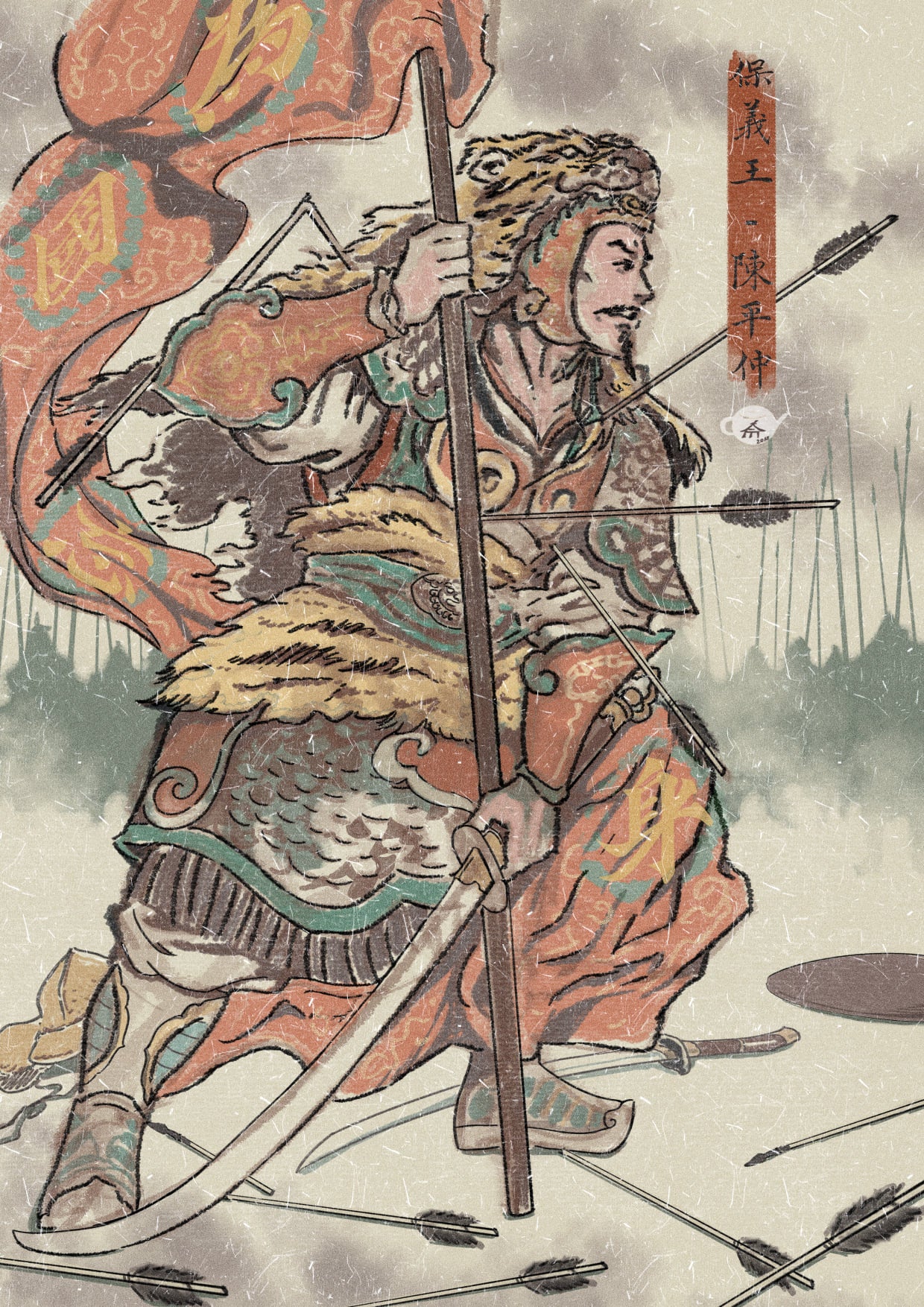
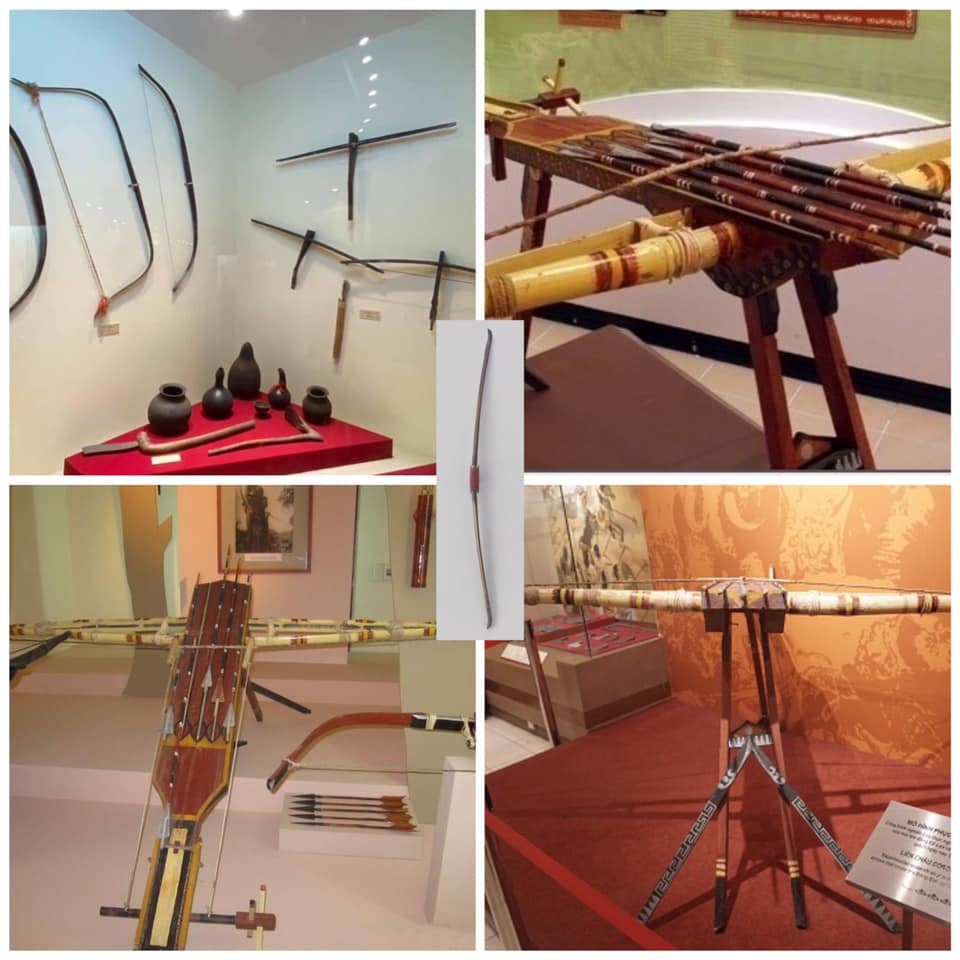
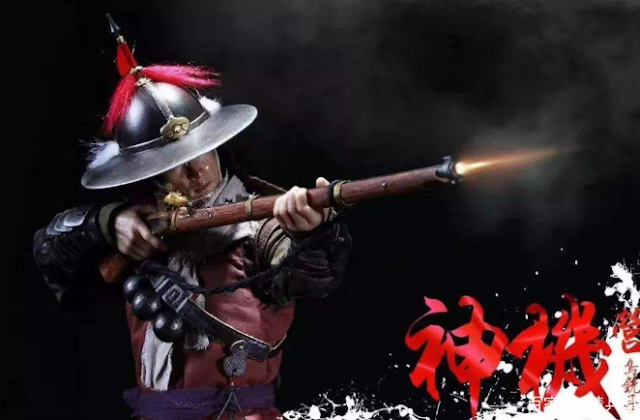
![[18+] BÌNH NGÔ ĐẠI CHIẾN (The Pacification Of The Wu) | VIỆT SỬ KIÊU HÙNG](https://forums.ageofempires.com/uploads/default/original/3X/f/c/fc4d8a4a1e79fe4e6cbd839286ccc5f07de74cb0.jpeg)
